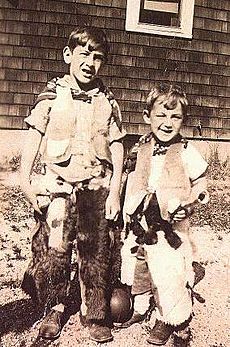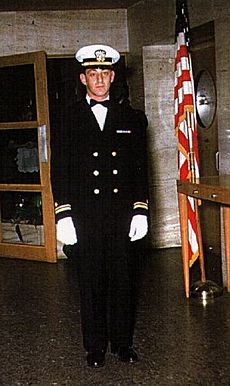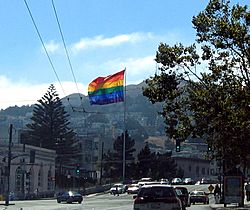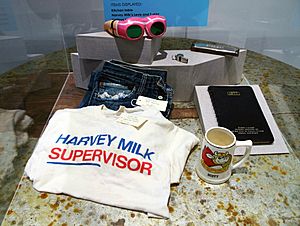Harvey Milk facts for kids
Quick facts for kids
Harvey Milk
|
|
|---|---|

Milk in June 1978
|
|
| Member of the San Francisco Board of Supervisors from the 5th district |
|
| In office January 8, 1978 – November 27, 1978 |
|
| Preceded by | Constituency established |
| Succeeded by | Harry Britt |
| Personal details | |
| Born |
Harvey Bernard Milk
May 22, 1930 Woodmere, New York, U.S. |
| Died | November 27, 1978 (aged 48) San Francisco, California, U.S. |
| Cause of death | Assassination |
| Political party |
|
| Relatives | Stuart Milk (nephew) |
| Education | State University of New York, Albany (BA) |
| Awards | Presidential Medal of Freedom (2009, posthumously) |
| Military service | |
| Allegiance | United States |
| Branch/service | United States Navy |
| Years of service | 1951–1955 |
| Rank | Lieutenant (junior grade) |
| Unit | USS Kittiwake (ASR-13) |
Harvey Bernard Milk (May 22, 1930 – November 27, 1978) was an American politician. He made history as the first openly gay man elected to public office in California. He served as a member of the San Francisco Board of Supervisors.
Contents
Early Life
Harvey Milk was born in Woodmere, New York, a suburb of New York City. His parents were William Milk and Minerva Karns. They were Lithuanian Jews. His grandfather, Morris Milk, owned a department store. He also helped start the first synagogue in their area.
As a child, Harvey was sometimes teased. He had ears that stuck out, a big nose, and large feet. He often got attention by being a class clown. In school, he played football. He also developed a strong interest in opera.
Milk finished Bay Shore High School in 1947. He then went to New York State College for Teachers in Albany, New York. This school is now called the University at Albany, SUNY. He studied mathematics there from 1947 to 1951. He also wrote for the college newspaper.
Career and Public Service
After college, Milk joined the United States Navy during the Korean War. He worked as a diving officer on the submarine rescue ship USS Kittiwake (ASR-13). Later, he moved to Naval Base San Diego. There, he served as a diving instructor. In 1955, he left the Navy as a lieutenant, junior grade.
Milk then taught at George W. Hewlett High School on Long Island. In 1956, he met Joe Campbell. They moved to Dallas, Texas, but were not happy there. They soon returned to New York. Milk got a job as a statistician at an insurance company. He and Campbell were together for almost six years. This was his longest relationship.
In 1972, Milk moved to San Francisco. He opened a camera store there. He had often changed jobs and homes before. But he settled in The Castro. This neighborhood was becoming home to many gay men and lesbians.
Milk decided to run for city supervisor in 1973. He faced challenges from other gay politicians. His campaign was very lively and theatrical. He was bold, outspoken, and energetic. He got a lot of media attention and votes. However, he was not elected that time.
He ran again in the next two supervisor elections. He called himself the "Mayor of Castro Street." People liked him more and more. This led him to also run for the California State Assembly. He used his growing popularity to fight against anti-gay laws.
In 1977, Milk was elected city supervisor. This happened after San Francisco changed its election rules. Now, representatives were chosen from neighborhoods, not the whole city.
Milk served for almost eleven months. During this time, he supported a bill. This bill would stop discrimination in public places, housing, and jobs. It was based on a person's sexual orientation. The Supervisors passed the bill with a vote of 11 to 1. Mayor George Moscone signed it into law.
On November 27, 1978, Milk and Mayor Moscone were killed. A former city supervisor named Dan White was responsible.
Lasting Impact
Even though his political career was short, Milk became a very important figure. He is seen as a hero in San Francisco. He also became a symbol for the gay community. In 2002, he was called "the most famous and most significant openly LGBT official ever elected in the United States."
Anne Kronenberg, who managed his last campaign, said he was a "visionary." She wrote that he "imagined a righteous world inside his head." Then, he worked to make it real for everyone. In 2009, Milk was given the Presidential Medal of Freedom. This award was given to him after his death.
Milk's political work focused on several key ideas. He wanted the government to listen to individuals. He supported freedom for gay people. He also believed neighborhoods were very important to a city.
Milk thought neighborhoods created a sense of togetherness. He felt they offered a small-town feeling. He believed the Castro neighborhood should help all its residents. He was against closing an elementary school. Even if most gay people in the Castro did not have children, Milk wanted the neighborhood to welcome everyone. He told his helpers to focus on fixing potholes. He was proud that 50 new stop signs were put in his district. He also made it a priority to pass a law about dog owners cleaning up after their pets. This was a big complaint from San Francisco residents.
Karen Foss, a professor, said Milk had a big impact on San Francisco politics. She wrote that Milk was "highly energetic" and "charismatic." He loved being dramatic and had nothing to lose. Milk used humor and his unique position to help people talk about important issues. He also helped bring together different groups of people. Milk was a powerful speaker since he started campaigning in 1973. His speaking skills got even better after he became City Supervisor. His most famous speeches were known as the "Hope Speech." These speeches became a regular part of his political career.
In his last year, Milk stressed that gay people should be more visible. He believed this would help end discrimination and unfair treatment.
Tributes and Memorials
The City of San Francisco has honored Milk by naming several places after him. An enormous Gay Pride flag flies where Market and Castro streets meet. This spot is called Harvey Milk Plaza. The San Francisco Gay Democratic Club changed its name in 1978. It became the Harvey Milk Memorial Gay Democratic Club. Today, it is called the Harvey Milk Lesbian, Gay, Bisexual, Transgender Democratic Club. It is the largest Democratic group in San Francisco.
In April 2018, the San Francisco Board of Supervisors and Mayor Mark Farrell approved a law. It renamed Terminal 1 at San Francisco International Airport after Milk. They also planned to add artwork to remember him. This followed an earlier try to rename the whole airport after him, which was not approved. Harvey Milk Terminal 1 officially opened on July 23, 2019. It is the first airport terminal in the world named after an LGBTQ leader.
In July 2016, US Secretary of the Navy Ray Mabus announced a plan. He intended to name a ship after Harvey Milk. This ship is the USNS Harvey Milk. It is part of the Military Sealift Command's John Lewis-class oilers. All ships in this class are named after civil rights leaders. The ship was launched in November 2021.
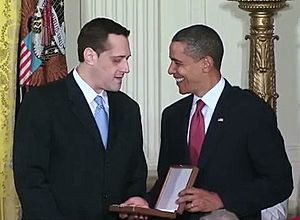
Harvey Milk's life has been featured in many forms of media. There has been a musical play and an opera about him. There is also a cantata, a children's picture book, and a French novel for young adults. The movie Milk was released in 2008. It was directed by Gus Van Sant. Sean Penn played Milk, and Josh Brolin played Dan White. The film won two Academy Awards.
Milk was included in Time magazine's "100 Heroes and Icons of the 20th Century." He was called "a symbol of what gays can accomplish."
In August 2009, President Barack Obama gave Milk the Presidential Medal of Freedom. This award was given after Milk's death. It recognized his bravery and belief in fighting for gay rights. Milk's nephew, Stuart Milk, accepted the award for him. Soon after, Stuart co-founded the Harvey Milk Foundation. Anne Kronenberg also helped start it.
Later that year, California governor Arnold Schwarzenegger named May 22 as Harvey Milk Day. He also added Milk to the California Hall of Fame.
In 2012, Milk was added to the Legacy Walk in Chicago. This is an outdoor display that celebrates LGBT history. He was also one of the first fifty Americans honored on the National LGBTQ Wall of Honor. This is located within the Stonewall National Monument in New York City. In 2019, Paris named a square Place Harvey-Milk in Le Marais after him.
See also
 In Spanish: Harvey Milk para niños
In Spanish: Harvey Milk para niños
- List of assassinated American politicians
- List of civil rights leaders
Images for kids
-
Milk, here with his sister-in-law in front of Castro Camera in 1973. His experiences in the 1960s had changed him. Dianne Feinstein, who met him in 1973, did not recognize him when they met again in 1978.
-
By the time of Milk's 1975 campaign, he had decided to cut his hair and wear suits. Here, Milk (far right) is campaigning with longshoremen in San Francisco during his 1976 race for the California State Assembly.
-
Rioters outside San Francisco City Hall, May 21, 1979, reacting to the voluntary manslaughter verdict for Dan White.


